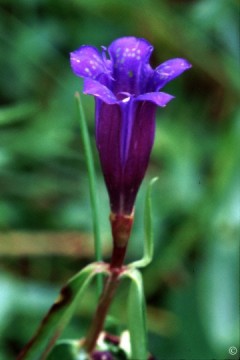 |
Pleated gentian, Gentiana affinis
Griseb. (left). The pleated gentian takes its common name from
an inward folding membrane that joins one petal to the next. As in this plant,
the petals often have a reticulated pattern of greenish spots on their upper
surfaces. Pleated gentians spread by sending out roots, and are often found
growing in clusters that sometimes suggest the “fairy rings” formed
by proliferating field mushrooms. Each of the pleated gentian’s stems
bears several pairs of small, opposite, lanceolate leaves and a terminal
flower. As with other members of this genus, this gentian prefers moist montane
meadows and the banks of lakes and streams.
Explorer’s gentian, Gentiana
calycosa Griseb. (right). The explorer’s
gentian (known also as the the mountain gentian or bog gentian) is the largest,
showiest, highest, and latest blooming of our gentians. It grows close to
treeline, in moist subalpine meadows and on the loamy banks of slow-flowing
streams. It sometimes blooms into September, accompanied only by lingering
asters and the ubiquitous yarrow. Its flowers are five-petaled, speckled
inside and, like the plant shown above, have a “pleat” connecting
the petals. The leaves tend to be wider than those of our other Gentiana.
Its species name, calycosa, from the Latin word for “calyx,” refers
in this case to the cup-shaped flowers. |
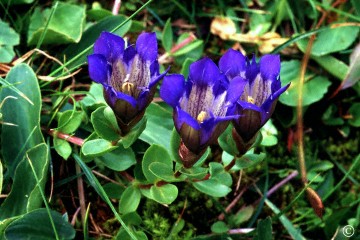 |
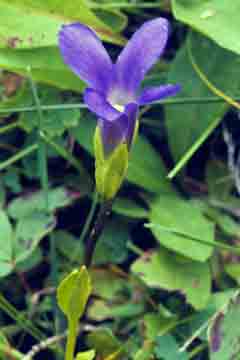 |
One-flowered gentian, Gentianopsis
simplex (A. Gray) Iltis
(left). The one-flowered gentian has a small and—as
its name suggests—a plain flower, noticeable mostly for its intense
blue color. Until recently classified in genus Gentiana, it is now
in Gentianopsis, a genus made up of similar four-petaled gentians.
It is a close relative of the Rocky Mountain fringed gentian (Gentianopsis
thermalis [Kuntze] Iltis., not shown), a plant that also grows in Idaho.
Both have four petals, but this one usually has little, if any, fringing
at the end of the petals. Both plants grow along streams, and in moist high
montane to subalpine meadows, blooming from mid-July through August. The
ending of the generic name, -opsis, is derived from the Greek word for
“view” or “looks like,” thus “a plant that looks
like (or is similar to) a gentian.”
Autumn dwarf-gentian, Gentianella amarella
(L.) Boerner (right). This is the daintiest of
our Gentianaceae. It flowers during the second half of August in moist, high
montane to subalpine meadows. With minor differences, the same plant ranges
across North America, Europe and Asia. Our plants are pink, but in other
places they may be off-white or even pale yellow. They may be identified
by the fringe of fine hairs inside the petals—shown here in a magnified
view. The species name amarella means “a little bitter.”
|
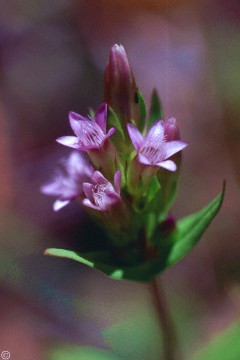 |
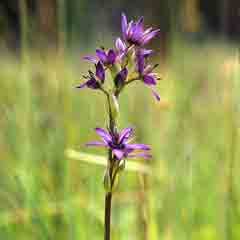 |
Swertia, Swertia perennis
L. (left, right). The swertia (also felwort or star gentian)
is the only member of its genus found in America. It is a late-blooming
circumboreal plant that grows in all of the western states, in British Columbia,
and in Eurasia. The plant favors wet montane to subalpine meadows. Its four
petals range in color from light purple to almost black, each petal has two
nectar pits at its base. The fruiting capsule is quite prominent. Emanuel
Sweert (1552-1612), was a Dutch botanist who composed a catalog of plants.
|
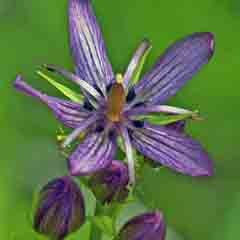 |
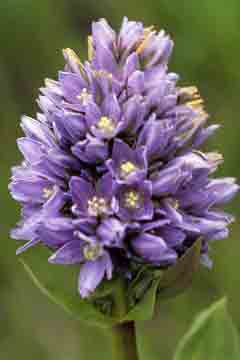 |
Clustered elkweed, Frasera
fastigiata (Pursh)
A. Heller (left). The clustered elkweed is found in
North-central Idaho (reported from Idaho, Latah, Lewis and Benewah counties)
and in the nearby Blue Mountains of Oregon and Washington. It is a tall,
large-leaved plant topped with four-petaled blue flowers. It is the only
member of the gentian family that Meriwether Lewis collecte, June 14th, 1806
on the Weippe Prairie. The name, fastigiata, implies
“cone-like” for the shape of the flower cluster.
White gentian, Frasera montana
Mulford (right). The white gentian grows in central
Idaho, north of Galena Summit (US Highway 75) in Custer county, west to Boise
county. A high montane plant, it blooms in late spring on dry ground, usually
in the company of sagebrush. Four- petaled, clustered flowers and white bordered,
narrow leaves serve to identify it.
|
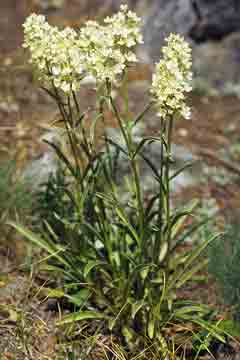 |
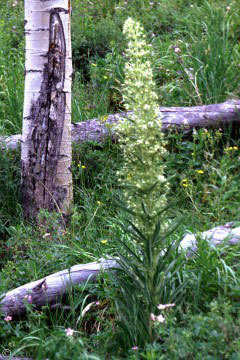 |
Monument plant, Frasera
speciosa Douglas ex Griseb.
(left, right), The monument plant (giant frasera, green gentian) is a tall,
narrow, cone-shaped plant with flowers clustered around the upper part of
its stem. The plants live for many years, but bloom only once and then die.
Flowering is unpredictable, but seems related to moisture. The flowers are
about 3/4'' diameter with a long sepal visible between each of its four
purple-spotted petals. Each petal has two pits at its base and four stamens
that surround a one-seed ovary. The plants, formerly pretty much confined
to valley floors, now grow as high as treeline. The name Frasera honors
John Fraser, (1750-1811), a Scots nurseryman who collected in southeastern
North America. The name speciosa means “showy.” |
 |









